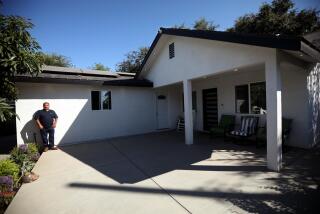. . . Even in Sluggish Southland Housing
- Share via
Although 1991 proved to be the worst year since World War II for the construction of new homes and apartments, experts said Wednesday they are encouraged by signs of an upturn that may indicate the long housing slump has bottomed out, even in Southern California.
Analysts nationwide have been waiting for evidence of a housing turnaround since a brief, post-Gulf War recovery lost steam late last summer despite falling interest rates. And now, with the slow pace of construction yielding a dwindling inventory of new homes and with mortgage rates lower than last summer, some experts think a housing rebound could be at hand.
The change in sentiment has come in the wake of new Commerce Department figures that show housing starts falling to a seasonally adjusted annual rate of 1.015 million units in 1991. Though the figure was the lowest since 1945, starts rose 2.6% in December after falling by a revised 1.4% in November.
Perhaps even more encouraging, the Commerce Department also reported that the number of new building permits surged by 5.9% during December, suggesting that home construction might pick up in the months ahead.
“The increase in housing permits for December suggests that low rates have started working their way through the economy,” John A. Tuccillo, chief economist for the National Assn. of Realtors, said in a statement released from the group’s Washington office. “Currently we are expecting housing starts to total 1.207 million units this year, which would represent an increase of 19% from 1991.”
In Southern California, the Economic Development Corporation of Los Angeles County is forecasting that housing starts will jump 20% to 50,200 units in 1992. Jack Keyeser, chief economist for the group, speculated that most of the improvement in the five county region will come in San Bernardino and Riverside counties, which enjoy relatively low land prices and low construction costs.
“Houses are selling but they are selling disproportionately at the entry level,” said Robert H. Edelstein, co-chairman of the Center for Real Estate and Urban Economics at UC Berkeley.
But the fortunes of the construction industry in 1992 will depend not only on moderating prices, an improved economy and low mortgage interest rates but also on the willingness of banks and thrifts to relax their stiff credit requirements for lending to real estate developers.
Low interest rates have fueled a huge home refinancing boom and drawn moderate numbers of entry-level home buyers into the market because mortgage money has been made freely available for home purchases and refinancings by banks and thrifts.
But so far, such lenders haven’t become any less tightfisted toward real estate developers in the three years since government regulators began putting pressure on banks and thrifts to tighten their credit standards.
Home building had been one of the few bright spots in the economy early in 1991, before that recovery began losing steam last September. Economists consider a rebound in housing an essential part of economic renewal because it indicates consumer willingness to spend and make long-term financial commitments.
Housing Starts Up in December, Down for Year Seasonally adjusted annual rate, millions of units Dec., ‘91: 1.10 Nov., ‘91: 1.08 Dec., ‘90: 0.97 Annual rate, millions of units 1945: 0.33 1972: 2.36 1986: 1.81 1991: 1.01 Source: Commerce Department
More to Read
Sign up for Essential California
The most important California stories and recommendations in your inbox every morning.
You may occasionally receive promotional content from the Los Angeles Times.





